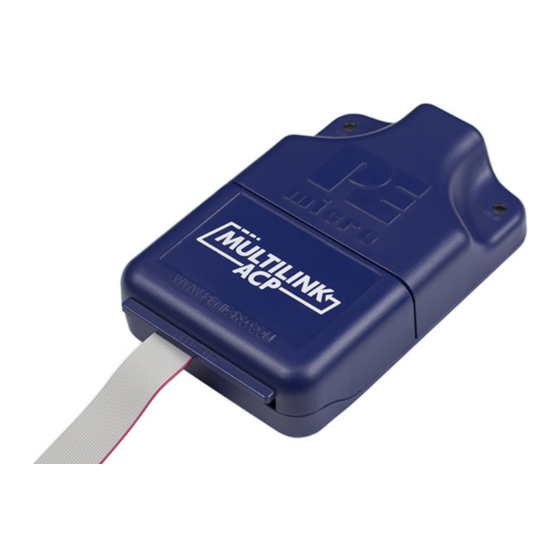
Table of Contents
Advertisement
Quick Links
P&E Microcomputer Systems, Inc.
Support for ARM Cortex processors (complete list at pemicro.com/arm)
1. Introduction
2. Device Support
3. Debug Headers
9. Third-Party IDEs & Other Compatible Software
1
Introduction
The USB Multilink ACP is a low-cost debug interface supporting a wide range of ARM Cortex processors. The Multilink provides
access to debug modes by communicating between the target device and a laptop/PC via the target's standard debug header
and a laptop/PC's USB port.
2
Device Support
Multilink ACP supports ARM Cortex-M devices from these manufacturers:
For a complete listing of supported ARM Cortex-M devices or to request support for a device, visit PEmicro at:
http://www.pemicro.com/arm
3
Debug Headers
Three standard ARM headers are located inside the unit. Port A is a dual-row header with a .100" pitch, while Ports B-C are
dual-row with a .050" pitch.
©2016-2020 P&E Microcomputer Systems, Inc.
ARM and Cortex are registered trademarks of ARM Limited (or its subsidiaries) in the US and/or elsewhere. All other trademarks are property of their respective owners.
www.pemicro.com
Technical Summary for
USB Multilink ACP, Rev. B
Document# PE3514, Version 1.04
NXP
·
Cypress Semiconductor
·
·
Infineon
·
Maxim Integrated
·
Microchp (Atmel)
Nordic Semiconductor
·
OnBright
·
(
PART# USB-ML-ACP)
USB Multilink ACP Debug Probe
· Redpine Signals
Silergy TeridianSilicon Labs
·
·
Silicon Labs
·
STMicroelectronics
·
Texas Instruments
Toshiba
·
WizNET
·
Advertisement
Table of Contents

Summary of Contents for P&E Microcomputer Systems USB Multilink ACP
- Page 1 Introduction The USB Multilink ACP is a low-cost debug interface supporting a wide range of ARM Cortex processors. The Multilink provides access to debug modes by communicating between the target device and a laptop/PC via the target's standard debug header and a laptop/PC's USB port.
- Page 2 Multilink port and the target processor header. The USB Multilink ACP is a USB device. If a USB Hub is used, it must be a self-powered hub (i.e. with its own power supply). By default, the USB protocol used is USB 2.0.
- Page 3 The following is the proper connection sequence to connect the PC to the target system via the Multilink interface: 1. Make sure the target power is OFF and the USB Multilink ACP is not connected to either the target or the PC 2.
- Page 4 Third-Party IDEs & Other Compatible Software The USB Multilink ACP is supported by recent versions of NXP’s MCUXpresso, CodeWarrior, Kinetis Design Studio, S32 Design Studio, STM32CubeIDE, and DAVE IDE, as well as third-party toolchains such as those from IAR, Keil, Silicon Labs.

Need help?
Do you have a question about the USB Multilink ACP and is the answer not in the manual?
Questions and answers